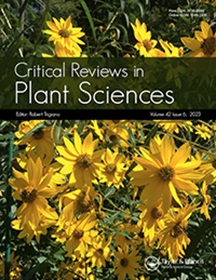Evolution of the Cotton Genus, Gossypium, and Its Domestication in the Americas
IF 6
2区 生物学
Q1 PLANT SCIENCES
引用次数: 5
Abstract
Abstract Gossypium, the cotton genus, includes ∼50 species distributed in tropical and sub-tropical regions of all continents except Europe. Here we provide a synopsis of the evolutionary history of Gossypium and domestication of the American allopolyploid species, integrating data from fundamental taxonomic investigations, biogeography, molecular genetics, phylogenetic analysis, and archaeology. These diverse sources of information provide a temporal and phylogenetic perspective on diversification among the diploids and on polyploid formation, uncover multiple previously cryptic interspecific hybridizations, clarify and contribute to the taxonomy of the genus, and offer a firm foundation for understanding parallel domestications in Mesoamerica and South America, which led to the globally important cotton crop species G. barbadense and G. hirsutum. Gossypium thus offers a testimonial example of the importance and utility of fundamental botanical discovery combined with modern technological capabilities to generate genomic insights into evolutionary history. We also review the current state of our knowledge regarding the archaeological history of cotton domestication and diffusion in the Americas, a seemingly unlikely story entailing parallel domestication origins and parallel directional selection tracing to 8,000 (G. barbadense) and 5,500 (G. hirsutum) years ago, transforming two geographically isolated wild short-day perennial shrubs having small capsules and seeds covered by short, tan-colored epidermal trichomes into modern daylength-neutral annuals bearing abundant, fine, strong white fibers. This dual domestication was followed several millennia later by unintentional and more recently intentional interspecific introgression, as the two species came into contact following their initial domestication in different hemispheres. Thus, the cycle of species divergence and biological reunion was reiterated, this time at the allopolyploid level. Understanding this evolutionary history is vitally important to our understanding of the genomic architecture of the world’s most important fiber plant and contributes substantially to our understanding of general biological principles.棉花属的进化及其在美洲的驯化
摘要棉花属Gossypium包括约50种,分布在除欧洲以外的所有大陆的热带和亚热带地区。在这里,我们综合了基础分类学研究、生物地理学、分子遗传学、系统发育分析和考古学的数据,提供了棉属进化史和美国异多倍体物种驯化的概要。这些不同的信息来源为二倍体之间的多样性和多倍体的形成提供了一个时间和系统发育的视角,揭示了多种以前隐蔽的种间杂交,阐明并有助于该属的分类学,并为理解中美洲和南美洲的平行驯化提供了坚实的基础,这导致了全球重要的棉花作物品种G.barbadense和G.hirsutum。因此,Gossypium提供了一个证明性的例子,证明了基础植物学发现与现代技术能力相结合,对进化史产生基因组见解的重要性和实用性。我们还回顾了我们对棉花在美洲驯化和传播的考古史的了解现状,这是一个似乎不太可能的故事,涉及平行的驯化起源和平行的定向选择,可以追溯到8000年前(G.barbadense)和5500年前(G.hirsutum),将两种地理上孤立的野生短日多年生灌木转化为现代的中性一年生植物,这些灌木具有小胶囊和种子,种子被短的棕褐色表皮毛状体覆盖,具有丰富、细、结实的白色纤维。几千年后,随着这两个物种在不同半球的首次驯化后接触,这种双重驯化之后出现了无意的和最近有意的种间渐渗。因此,物种分化和生物团聚的循环被重申,这一次是在异源多倍体水平上。了解这一进化史对我们理解世界上最重要的纤维植物的基因组结构至关重要,并对我们理解一般生物学原理做出重大贡献。
本文章由计算机程序翻译,如有差异,请以英文原文为准。
求助全文
约1分钟内获得全文
求助全文
来源期刊
CiteScore
12.90
自引率
1.40%
发文量
15
审稿时长
>12 weeks
期刊介绍:
Critical Reviews in Plant Sciences focuses on presenting in-depth and up-to-date reviews of timely and/or cutting-edge subjects in the broad discipline of plant science, ranging from molecular biology/biochemistry through the areas of cell biology, plant pathology and physiology, genetics, classical botany, and ecology, to practical agricultural applications. Articles in the journal provide an up-to-date literature base for researchers and students, pointing the way towards future research needs. The journal is also a significant source of credible, objective information to aid decision makers at all levels.

 求助内容:
求助内容: 应助结果提醒方式:
应助结果提醒方式:


